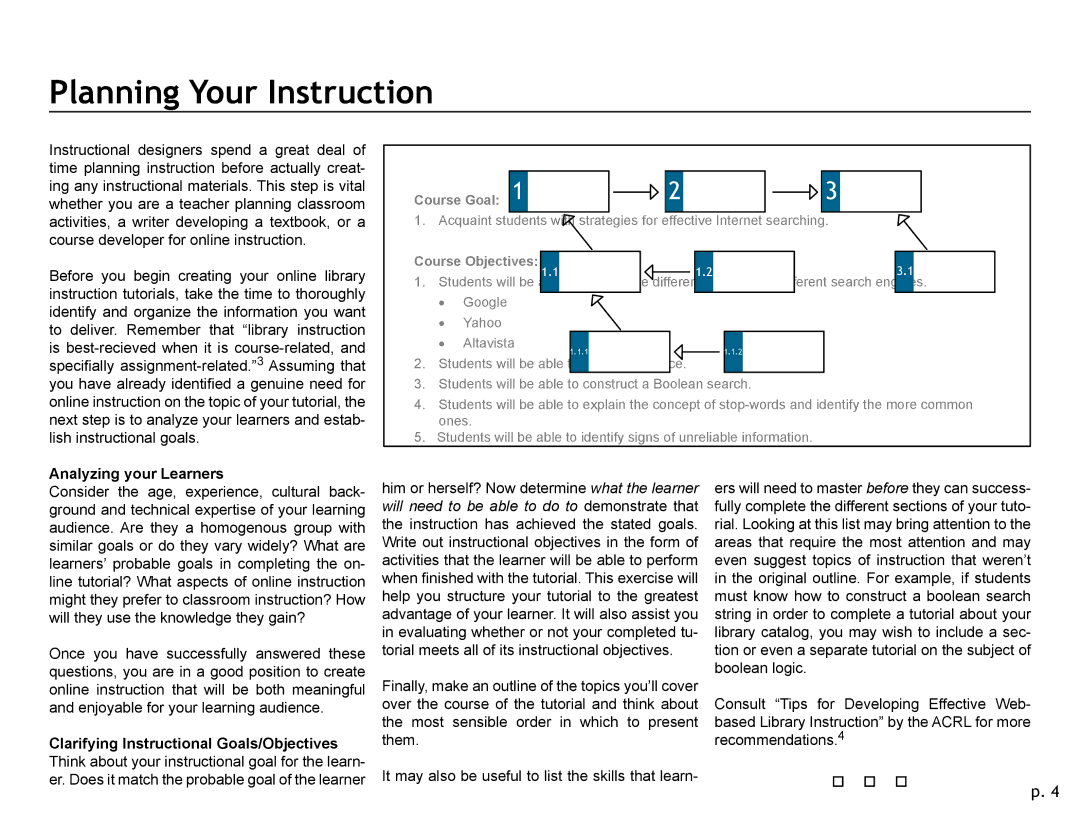
Planning Your Instruction
Instructional designers spend a great deal of time planning instruction before actually creat- ing any instructional materials. This step is vital whether you are a teacher planning classroom activities, a writer developing a textbook, or a course developer for online instruction.
Before you begin creating your online library instruction tutorials, take the time to thoroughly identify and organize the information you want to deliver. Remember that “library instruction is
Course Goal: 1 | 2 | 3 |
1. Acquaint students with strategies for effective Internet searching.
Course Objectives: | 1.1 |
|
|
|
|
| 1.2 |
|
|
|
|
| 3.1 | ||
1. | Students will be |
|
|
|
| differences |
|
| different search engines. | ||||||
| • |
|
|
|
|
|
|
|
|
|
|
|
|
| |
| • | Yahoo |
|
|
|
|
|
|
|
|
|
|
|
|
|
| • | Altavista |
|
| 1.1.1 |
|
|
|
|
| 1.1.2 |
|
|
|
|
2. | Students will be able |
|
| . |
|
|
|
|
|
| |||||
|
|
|
|
|
|
|
|
|
| ||||||
3.Students will be able to construct a Boolean search.
4.Students will be able to explain the concept of
5.Students will be able to identify signs of unreliable information.
Analyzing your Learners
Consider the age, experience, cultural back- ground and technical expertise of your learning audience. Are they a homogenous group with similar goals or do they vary widely? What are learners’ probable goals in completing the on- line tutorial? What aspects of online instruction might they prefer to classroom instruction? How will they use the knowledge they gain?
Once you have successfully answered these questions, you are in a good position to create online instruction that will be both meaningful and enjoyable for your learning audience.
Clarifying Instructional Goals/Objectives Think about your instructional goal for the learn- er. Does it match the probable goal of the learner
him or herself? Now determine what the learner will need to be able to do to demonstrate that the instruction has achieved the stated goals. Write out instructional objectives in the form of activities that the learner will be able to perform when finished with the tutorial. This exercise will help you structure your tutorial to the greatest advantage of your learner. It will also assist you in evaluating whether or not your completed tu- torial meets all of its instructional objectives.
Finally, make an outline of the topics you’ll cover over the course of the tutorial and think about the most sensible order in which to present them.
It may also be useful to list the skills that learn-
ers will need to master before they can success- fully complete the different sections of your tuto- rial. Looking at this list may bring attention to the areas that require the most attention and may even suggest topics of instruction that weren’t in the original outline. For example, if students must know how to construct a boolean search string in order to complete a tutorial about your library catalog, you may wish to include a sec- tion or even a separate tutorial on the subject of boolean logic.
Consult “Tips for Developing Effective Web- based Library Instruction” by the ACRL for more recommendations.4
p. 4
